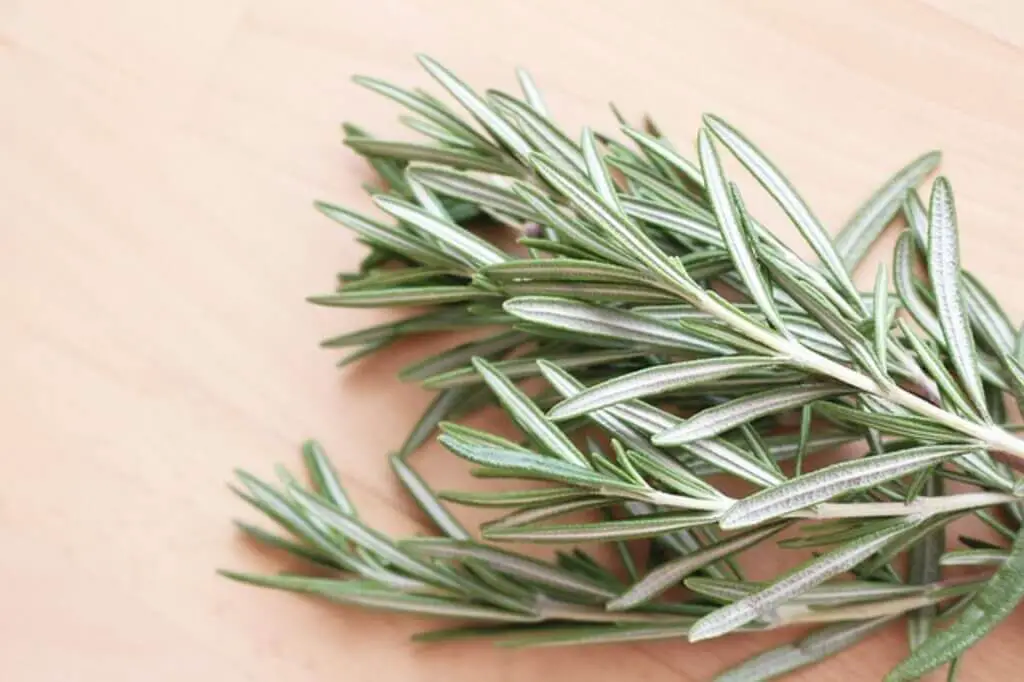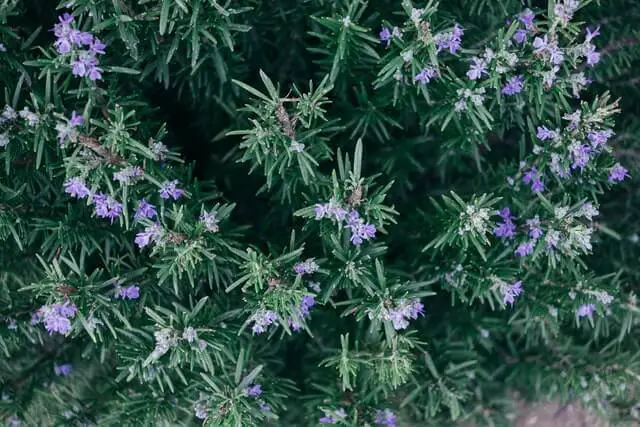51 Fun Facts About Rosemary (with Photos & Information)
One fascinating herb with a variety of culinary and medicinal uses is rosemary. It’s one of those plants that has been around for centuries, and even today it is still popular among herb gardeners and chefs alike. In this post, we’ll be going over 51 fascinating facts about rosemary that you may not have known before!
Overview
- Order: Lamiales
- Family: Lamiaceae
- Genus: Salvia
- Species: S. Rosmarinus
- Scientific Name: Salvia rosmarinus
- Plant Type: Perennial but may also be grown as an annual.
- Flower Color: Small whitish-pink and bluish-purple flowers.
- Propagation: Stems, seeds or cuttings.
- Height: Trailing type: 12 – 36″ inches. Upright Type: 36 – 96″ inches.
- Width: 24 – 48″ inches.
- Zones: 8, 9, and 10.
Description
The Rosemary Plant is a type of evergreen shrub that grows in warm climates. Most of the species grow to an average of 3 feet tall, but some varieties can grow up to 8 feet, and all varieties have woody stems.
The leaves are narrow, and its color can range from dark green to light gray-green. The flowers come out during the summer and resemble small purple cones or little white pompoms (depending on the variety).
Fun Facts About Rosemary
- Rosemary is a plant of the mint family with fragrant evergreen leaves. The plant is native to the Mediterranean region, but it has been introduced into many other regions of Europe and around the world.
- The name comes from the Latin “ros marinus” meaning “dew of the sea”. This refers to rosemary’s fresh smell, which resembles that of an ocean breeze. For ancient Greeks and Romans, it symbolized remembrance because its flowers are particularly long-lasting.
- Rosemary can grow up to 2 meters (80 inches) tall. The stem is woody near the base and grows into long, green needle-like leaves that are most often used in cooking.
- The flowers of the rosemary plant are white with 4 petals and grow in clusters of 2-5 blooms on top of spiny branches. They bloom during spring or early summer, depending on climate – they bloom earlier in cooler climates. Rosemary is not self-fertile; cross-pollination must occur for seeds to be produced, so it can sometimes be challenging to grow this herb if you live in a small space like an apartment.
- Rosemary is associated with remembrance because its petals last longer than other flowers. The flower’s fragrance has also been used to keep memory.
- It is a herb that can grow in deep shade, but it does well in full sun too. Its growing conditions are similar to those of lavender. Rosemary is mostly grown outdoors, although it can also be grown inside at home or office spaces.
- Rosemary may be used fresh or dried for medicinal purposes. It is often found in baking, cooking and pickling spice mixes. Rosemary is a great herb to use in soups, stews and sauces for cooking or baking.
- When dried, rosemary does not lose its scent. However, it is possible to lose the flavor if it is chopped too much or burnt at high temperatures.
- Rosemary can be used traditionally in healing rituals for enhancing the memory. It has been used as an ingredient in incense, perfumes and aromatherapy oils since ancient times. The plant is often used as a seasoning in Mediterranean cuisine with pasta dishes, pastas and breads. It can also be used alone with meat, fish or poultry dishes to enhance the flavor without over powering it with an overpowering scent or taste.
- The myth that rosemary wards off vampires began in an 11th century monastery, a place where the herb was used as a natural insect repellent.
- Rosemary is not related to “sage” and is actually part of the mint family. Some say it’s so closely tied to there that it should be classified as such instead of belonging with its own family.
- The ancient Egyptians were the first people to use rosemary as food and medicine. They also employed it for embalming and used its aromatic oils for perfumes and incense.
- In the Middle Ages, rosemary was believed to stimulate the brain as well as warding off evil spirits. In some countries, it’s still believed that a sprig of rosemary on the doorstep protects from evil.
- In France, Greece and other Mediterranean countries, fresh rosemary is used as a main ingredient in salads. It has long been popular to cook with in Italian and European dishes.
- Britain is one of the largest consumers of rosemary products in Europe. The island imports an estimated 50% of their eating rosemary directly from its native Mediterranean regions (Spain, Italy, Syria).
- Rosemary has over 3 times more iron than spinach; it also has very high levels of antioxidants and vitamin A.
- Rosemary symbolizes remembrance and friendship.
- In a medieval love tale, The Romance of the Rose, the rosemary was famed as the “emblem of faithful love”. Roses were growing by its side and when they were destroyed, rosemary became the sole survivor. When the garden was ravaged by fire, this herb also survived, and it became known as “the symbol of enduring fidelity”.
- In Ancient Greece, it was said that an old man who desired to enrich his knowledge should eat rosemary. The Greeks believed that eating this herb would improve their memory and learning capabilities.
- In Ancient Rome, rosemary was used as a symbol of friendship because the Romans believed that the herb could be used to strengthen friendships. It was also believed that by eating a few leaves, one would experience a renewed sense of love.
- Pliny the Elder used it as a tonic for patients suffering from digestive disturbances, and he recommended adding it to wine to help regulate bile secretions.
- A popular folk remedy at the time was for people suffering from jaundice to eat some rosemary leaves with their dinner, especially on Christmas Eve. It was believed that this would stop the body’s bile ducts from getting blocked and prevent jaundice.
- The name “Rosemarinus” comes from the Latin word meaning “dew of the sea.”
- Rosemary can grow up to 3 feet high in a temperate climate.
- Rosemary leaves were used by Scottish clans as a symbol of remembrance, faithfulness or love for their absent friends.
- Rosemary can be used in the bath to help relieve pre-menstrual tension.
- Rosemary oil was used in paint to prevent yellowing.
- The “Scented Rosemary” plant that is grown for natural air freshener is not really rosemary at all… it’s actually chamomile! The essential oil in these plants has elements of both, so much so that they can often confuse customers when shopping for their product, leading them to believe that the whole plant is made up of essential oils when in reality it’s only one third of the plant.
- Rosemary is common in Roman religion, often associated with Roman holidays like the Lupercalia (wolf-pack feast), and the Festival of Good Souls (Festival of the Dead).
- Herbs like rosemary were also thought to ward off evil spirits in Roman times.
- The Ancient Romans believed that rosemary was one of three herbs that would allow a person to become an empress. These three herbs are all considered impotence herbs today.
- The ancient Greeks also associated rosemary with the gods, believing that Aphrodite had passed on her beauty to it so that it would be the most beautiful plant in the world.
- Rosemary was used in ancient Rome for fertility purposes. It was thought that if a man placed rosemary under his pillow while he slept, he would have prophetic dreams about his future children.
- A powerful medicinal property of rosemary is its ability to relax muscles and relieve tension headaches due to its volatile oils.
- Ancient Greek women used to chew on sprigs of rosemary to achieve a natural “high” while meditating.
- Rosemary contains ursolic acid, making it great for muscle aches and spasms.
- In the 19th century, it was popular to be buried with dried Rosemary because people believed that smelling the herb would bring them back from the dead.
- The “rosemary scrub” is a popular household remedy for treatment of itching; however, there’s no evidence that it actually works.
- Rosemary was the only herb to appear in all the four major world religions (Catholicism, Judaism, Islam and Greek Orthodoxy).
Rosemary Grow Tips
- Plant Rosemary with other herbs like basil or thyme that are similar in climate needs
- Give it plenty of sunlight; they prefer full sun (6 hours), but can tolerate partial shade if necessary.
- Make sure the soil drains well, as they dislike wet roots.
- Plant in late spring or early summer (June-July), and harvest when leaves are dry and no longer fragrant.
- Make sure the plant gets enough water, but not too much or too little so that it doesn’t dry out. (Watering too much will cause root-rot). When watering, water deeply until the soil is wet, then wait until the top 1 inch of soil dries out before watering again.
- Start with the right soil mix – this will make all the difference in how your plants thrive or wither away. Mix two parts potting soil with one part sand and add some fertilizer like composted manure for an extra boost of nutrients.
- Plant between 6 inches and 1 foot apart, so they can share nutrients.
- Trim back flower stalks after blooming to keep the plant looking neat and compact.
Related Articles:









